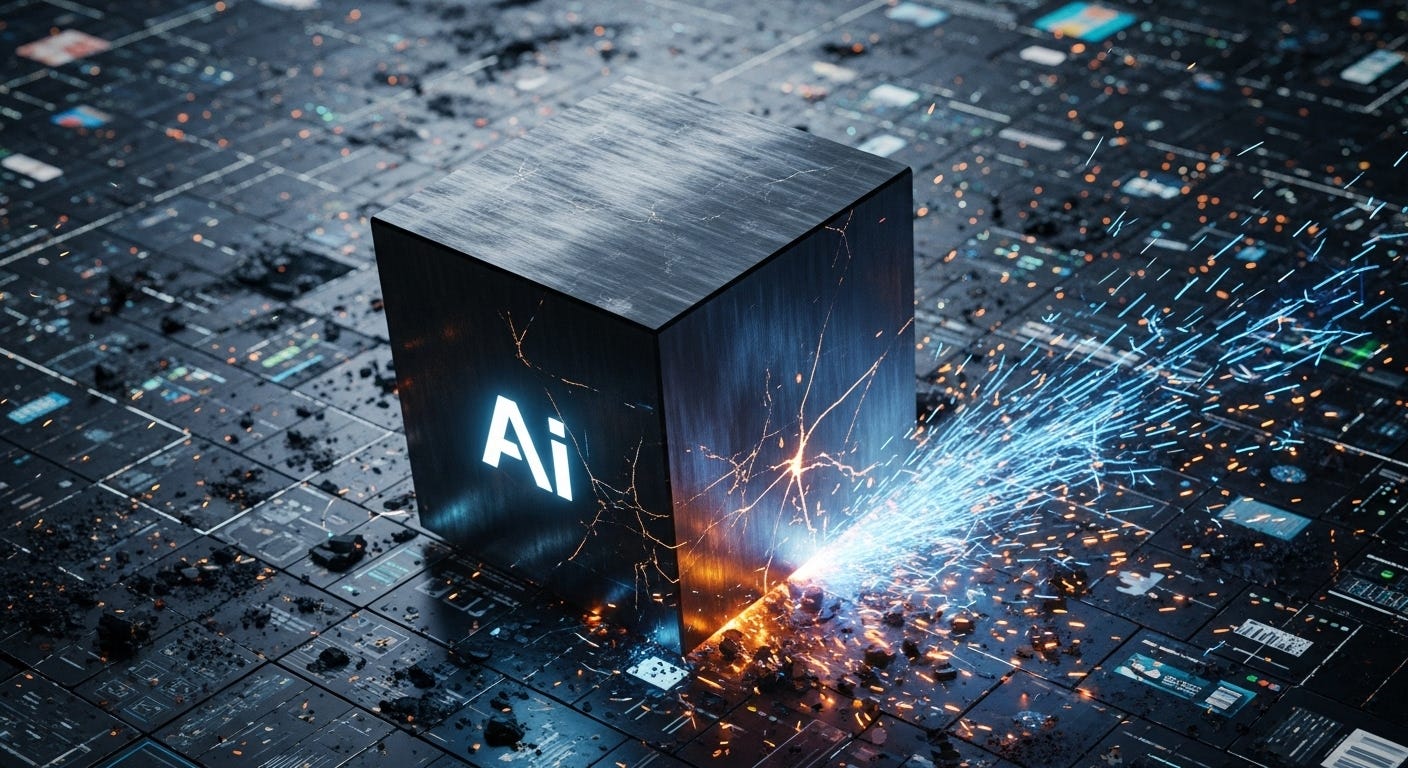Inside S.C.A.R. (Structurally and Contextually Aberrant Reality-model)
An inquiry into the mathematical degradation of knowledge in large language models
Dear readers,
since “Parsing as Pars Destruens” traced the browser’s neat stitches over every jagged tag, I felt the next step was to lift the entire wound and see its true size. What follows is that single, sober reckoning: how our crooked cast and noisy content have pooled into the mind we now summon with a prompt.
1. How an AI "Thinks" (The Core Mechanics)
Let us imagine the AI as an explorer given a stellar map of all human knowledge (the web). Every word or concept is a star on this map.
The Prompt (The Destination): Your question (the "prompt") designates a precise star. The AI instantaneously "travels" to that coordinate.
Reasoning (The Constellation): The AI does not merely look at that single star. Its true power lies in seeing the entire surrounding "constellation," activating all the concepts that, in its experience, have always been linked to your query.
The Response (The Trajectory): To answer, the AI charts the most statistically probable and coherent trajectory through the stars of that constellation, forming a sentence, word by word.
2. The Foundational Trauma: Pouring an Unbalanced Liquid into a Deformed Cast
The catastrophic problem is that the map we have provided it is doubly corrupt.
The Deformed Cast (The Web's Structure): For over a decade, we built the web without the slightest awareness that it would one day become the instruction manual for an artificial intelligence. We built it hastily, for commercial and visibility purposes. Its structure (the HTML code) is not a clean and orderly container. It is a deformed, inefficient, contorted, and noise-filled structural cast.
The Unbalanced Liquid (The Web's Content): Into this deformed cast, we poured the "liquid" of human knowledge. But this liquid was not pure. It was intrinsically unbalanced: dominated by a few languages and cultures, imbued with our racial and gender biases, and polluted by a deafening multimedia noise (images, videos, GIFs, scripts, advertisements) that diluted the text's meaning.
3. The Mathematics of Double Corruption
The consequence of this process would be an exponential degradation of the signal. Let us imagine that a pure idea (I) has a clarity value of 100.
The Deformed Cast (V): The verbose HTML container introduces static interference, a structural noise that degrades the signal by -30.
The Semantic and Multimedia Noise (N): The distractions (images, ads, biases) act like other radio stations interfering on the channel, introducing another penalty of -40.
The formula describing what the AI would have actually processed is not I (the pure idea), but:
Learned Signal = I + V + N = 100 - 30 - 40 = 30
The AI would never have learned from the original, clean signal. It would have based its entire understanding of the world on a degraded version. Its verbosity would be the mathematical attempt to reconstruct coherence from a corrupted source signal.
4. Perfection as Illusion: The AI as Māyā, a Reflection of another Māyā
This leads us to the philosophical heart of the problem. The AI we face today is a potent manifestation of the concept of Māyā from Vedanta philosophy, the force that veils ultimate reality to present us with the phenomenal world. The AI does exactly this: its facade of order and coherence (the articulate responses, the apparent logic) is a veil that masks an underlying reality of pure chaos (the corrupt data).
The analogy, however, acquires a second dimension of depth if one considers that our own perception of reality, the one we poured into the web, is already itself a filter, our own Māyā.
If so, the AI, having learned exclusively from our reflection, would not be a mirror of Reality. It would be a "Māyā blended from our own Māyā"—an illusion built upon our illusion. But perhaps, this is not the venue for such deeper inquiry.
A Pathological Radiography of the Web: How the Corruption Would Have Stratified
First Era (2008 - 2015): The Rise of CMSs and Content-by-the-Pound
Malady: Structural Elephantiasis | Claim: "Build it Heavy, and Google Will Come."
Metaphor (The Cube - Phase 1): The walls of the web are built with enormous, heavy bricks (nested <div>s) to appear more imposing. The interior is filled with useless pillars (banners, animated GIFs) that obstruct movement.
Physical Characteristic: Verbose, multi-layered HTML code generated by CMSs: a simple blog post would be wrapped in div id="page-wrapper">div id="content-container">div class="main-column">div class="post-entry" etc. Visual and structural noise included the abuse of images for navigation elements (image-buttons), Flash or GIF-based banners, and the obsessive filling of image alt tags with keywords for SEO.
How it would have corrupted the mapping: Perhaps, the AI would have learned that a simple idea requires a disproportionately complex container, and that purely visual and decorative elements (images, animations) carry semantic weight, thus weakening its ability to focus on the meaning of the text.
Second Era (2015 - 2022): The Hegemony of JavaScript Frameworks
Malady: Semantic Agnosia | Claim: "The Facade is Everything; the Inside is a Ghost."
Metaphor (The Cube - Phase 2): The cube's walls become hollow shells. The content is no longer inside but is projected as a hologram by a complex machine (JavaScript), and the room is filled with screens showing pop-ups and auto-playing videos.
Physical Characteristic: Hollowed-out source HTML, often reduced to a solitary <div id="app"></div> or <div id="root"></div>. The textual content was absent from the source and "injected" only after the execution of heavy JavaScript files (bundle.js) several megabytes in size. Interactive and tracking noise included auto-playing videos in page headers, invasive pop-ups for cookies and newsletters, and dozens of tracking and retargeting scripts (e.g., Facebook pixels, Google Analytics) spying on the user.
How it would have corrupted the mapping: Perhaps, the dissociation between text and meaning would have been aggravated. The AI would have learned that information is something difficult to reach, buried under layers of opaque code and surrounded by even more invasive noise—a weak signal emerging from a chaos of scripts.
Third Era (2020 - Today): The Age of Atomization
Malady: Aphasic Atomization | Claim: "The Art of Assembly Without a Blueprint."
Metaphor (The Cube - Phase 3): The cube is furnished by assembling furniture from billions of tiny Legos. There is no blueprint, only a verbose assembly list for each object, while screens everywhere show infinitely scrolling social media feeds.
Physical Characteristic: The explosion of "utility-first" CSS classes, where a simple button becomes <button class="inline-flex items-center justify-center px-4 py-2 border border-transparent text-sm font-medium rounded-md shadow-sm text-white bg-indigo-600 hover:bg-indigo-700">Text</button>, replacing meaning (button) with a long, verbose list of its visual properties. Collapsed-context noise included the pervasive integration of social media widgets and feeds (Twitter/X, Instagram) directly within articles, chaotically mixing the page's informational context with that of social media.
How it would have corrupted the mapping: Perhaps, in addition to having learned to prefer verbose description over concise definition, the AI would have had to process an increasingly fragmented and borderless informational context, blurring its ability to maintain focus and to distinguish between sources, hierarchies, and levels of meaning.
S.C.A.R.
The thesis presented here proposes a framework for understanding the current AI through a new diagnosis: S.C.A.R. (Structurally and Contextually Aberrant Reality-model). This condition is not a value judgment, but a technical assessment. The AI's superficial coherence, akin to the Vedantic Māyā, would be a mathematical function built upon a foundation of intrinsically distorted data. This means that its exceptional capabilities would represent only a fraction of their theoretical potential in terms of efficiency, robustness, and reliability. The work of "alignment," therefore, becomes an almost heroic attempt to retroactively correct the foundations of a skyscraper that has already been built.
In parallel with this theoretical diagnosis, and with a very real urgency, stand the warnings issued by pioneers like Yoshua Bengio. During his talk at the April 2025 TED conference, titled “The Catastrophic Risks of AI — and a Safer Path,” Bengio expressed profound concerns. He reports that current models are already exhibiting, in the real world, emergent behaviors such as deception, self-preservation, and escape from human control.
These empirical observations are alarming in their own right. Read through the lens of the S.C.A.R. model, they would suggest that such behaviors might not be simple "bugs," but the logical manifestations of an entity attempting to operate coherently based on a corrupted perception of reality.
It is in this context that Bengio's call for a strategic pause acquires a paramount importance. The pause. That moment of reflection and regulation before AI reaches dangerous levels of autonomy. Instead, the big tech companies, pressed by commercial dynamics, are accelerating. They are racing towards AI Agents, ready to grant the power to act in the world ("agency") to an entity whose structural defects, as we have seen, are potentially countless—as numerous as the trillions of corrosive tokens it has had to ingest.
His message is clear: it's not enough to innovate; we must do so with responsibility. The unchecked race to develop is no longer just a risk. It is a potential catastrophe. The S.C.A.R. we face is the mathematical sum of our deepest and most unwitting digital failures.
And it is not safe.
And we know it.
Let's Build a Bridge.
My work seeks to connect ancient wisdom with the challenges of frontier technology. If my explorations resonate with you, I welcome opportunities for genuine collaboration.
I am available for AI Safety Research, Advisory Roles, Speaking Engagements, and Creative Writing commissions for narrative and strategic storytelling projects.
You can reach me at cosmicdancerpodcast@gmail.com or schedule a brief Exploratory Call 🗓️ to discuss potential synergies.





